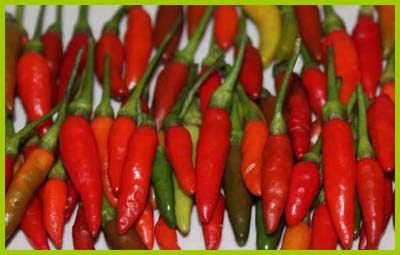Chilli
 Chilli peppers are a small, fiery variety of capsicum. They can be green, yellow, orange, red or black. There are more than 200 known varieties and they differ greatly in size, colour and level of hotness. In general, the smaller the chilli, the more potent, but it is worth bearing in mind that individual chillies of the same variety and even from the same plant can contain different levels of capsaicin, the volatile oil that gives chilli its heat. There is an official heat scale for chillies known as The Scoville scale, developed by Wilbur Scoville in 1912. A sweet pepper scores 0 on the scale, Jalapeño and chipotle chillies score anything between 2,500 to 10,000 and habañero and Scotch bonnet score 80,000 to 300,000 plus! Chillies work well in sweet as well as savoury dishes: a little chilli helps to cut through the richness of the chocolate. Source: http://www.bbc.co.uk/food/chilli
Chilli peppers are a small, fiery variety of capsicum. They can be green, yellow, orange, red or black. There are more than 200 known varieties and they differ greatly in size, colour and level of hotness. In general, the smaller the chilli, the more potent, but it is worth bearing in mind that individual chillies of the same variety and even from the same plant can contain different levels of capsaicin, the volatile oil that gives chilli its heat. There is an official heat scale for chillies known as The Scoville scale, developed by Wilbur Scoville in 1912. A sweet pepper scores 0 on the scale, Jalapeño and chipotle chillies score anything between 2,500 to 10,000 and habañero and Scotch bonnet score 80,000 to 300,000 plus! Chillies work well in sweet as well as savoury dishes: a little chilli helps to cut through the richness of the chocolate. Source: http://www.bbc.co.uk/food/chilli
Ginger
 Ginger or ginger root is the rhizome of the plant Zingiber officinale, consumed as a delicacy, medicine, or spice. It lends its name to its genus and family. Other notable members of this plant family are turmeric, cardamom, and galangal. Source: http://en.wikipedia.org/wiki/Ginger
Ginger or ginger root is the rhizome of the plant Zingiber officinale, consumed as a delicacy, medicine, or spice. It lends its name to its genus and family. Other notable members of this plant family are turmeric, cardamom, and galangal. Source: http://en.wikipedia.org/wiki/Ginger
Onion
 The onion, also known as the bulb onion or common onion, is used as a vegetable and is the most widely cultivated species of the genus Allium.
The onion, also known as the bulb onion or common onion, is used as a vegetable and is the most widely cultivated species of the genus Allium.
An essential kitchen vegetable, onions are arguably the world’s most widely used ingredient. They vary in shape and colour from flattish brown to round pale bulbs but share a common structure, with a papery outer skin and protecting inner layers of pale, crisp flesh. Yellow onions are hot and pungent enough to make your eyes water; Spanish onions are the largest, with brown skin and a mild, sweet flavour; brown onions are a smaller variety of yellow onion with an even more pungent flavour, making them a good all-rounder. Source: http://www.bbc.co.uk/food/onion



